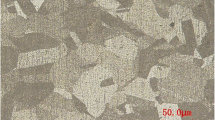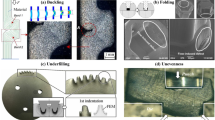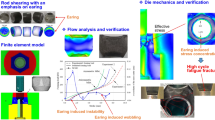Abstract
During metal forging, warping can easily occur on the edge of the thin flange, causing it to fold, affecting the sustainability of the application of the flange. This investigation proposes a chamfer design for the die and the taper design for the ring gap, to eliminate warping. First, the radial forging process of work-hardened materials is simulated, the phenomenon of flange warping is analyzed, and the accuracy of the simulation is experimentally verified. Secondly, the materials, lubricants and the height of the ring gap of the die are set as fixed parameters, and the analytical results for dies with rounded corner, chamfered and a tapered of the ring gap, are compared. The experiments and simulation confirm that the problem of flange warping can be solved effectively. The results are as follows.
When the die has a rounded corner and R=2 mm, serious warping and breaking creases are observed alongs the rim of the flange. When the die is designed with a chamfer, experiments and simulation both demonstrate that warping is reduced slowly as the chamfer value increases. When the die corner has a radius of R=2 mm, and has a taper shape between the rounded corner and the ring gap, experiments and simulation both indicate that warping declines as the tapering increases. However, as the contact area between the raw material and the die increases, its forming load increases with the taper angle. All of these results indicate that the solution to the warping problem proposed herein is feasible and effective, and that the results of this study represent useful references for design dies for radial forging.
Similar content being viewed by others
References
C.C. Chen, Shiro Kobayashi, “Rigid plastic finite element analysis of ring compression”, Applications of Numerical Methods to Forming Processes, vol. 28 pp 163–174, 1978.
Lee, C.H. and Altan, T., “Influence of flow stress and friction upon metal flow in upset forging of ring and cylinders”, J. Engr. For Industry, Trans. ASME, pp 775–782, 1972.
R. Balendra, “Process mechanics of injection upsetting ”, Int. J. Mach. Tool Des. Res. Vol. 25, No. 1, pp 63–73, 1985.
R. Balendra, M.A. Hijazi, “Evaluation of injection upsetting models”, Int. J. Mach. Tools & Manufacture vol. 29, No. 3 pp 345–360, 1989.
R. Balendra, and Qin. Y., “FE simulation of the development of flaws during injection forging”, Int. J. Mach. Tools & Manufacture vol. 34, No. 8 pp 1091–1101, 1994.
T. Nishimura, T. Sato, Kyin Hoke, Y. Tada, “A method for the evaluation of lubrication using injection upsetting”, Journal of Materials Processing Technology 53, pp 712–725, 1995.
T. Nishimura, T. Sato, Y. Tada, “The evaluation of anti-galling characteristics by observation of adhesion morphologies using injection upsetting”, Journal of Materials Processing Technology 62, pp 235–241 , 1996.
Beong Du Ko, Dong Joon Kim, Soo Hyung Lee, Beong Bok Hwang, “The influence of die geometry on the radial extrusion processes”, Journal of Materials Processing Technology 113, pp 109–114, 2001.
Chun-Yin Wu, Yuan-Chuan Hsu, “The influence of die shape on the flow deformation of extrusion forging”, Journal of Materials Processing Technology 124, pp 67–76, 2002.
Yong-Taek Im, Jae-Seung Cheon and Seong-Hoon Kang, “Determination of friction condition by geometrical measurement of backward extruded aluminum alloy specimen”, ASME J. Manuf. Sci. Eng., 124, pp 409–415, 2002.
Author information
Authors and Affiliations
Corresponding author
Rights and permissions
About this article
Cite this article
Hsiang, SH., Ho, HL. A Study on the Warping Problems of Thin Flange under the Radial Forging Processes by FEM and Experiments. Int J Adv Manuf Technol 26, 47–55 (2005). https://doi.org/10.1007/s00170-003-1985-3
Received:
Accepted:
Published:
Issue Date:
DOI: https://doi.org/10.1007/s00170-003-1985-3




